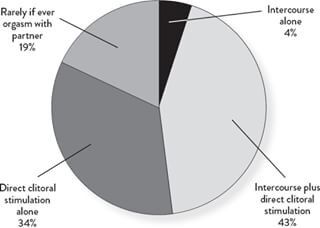Sex
Birds, Bees, and BS: The Missing Female Orgasm in Sex Ed
Sex Ed contributes to the high percentage of women who don't orgasm.
Posted November 30, 2020 Reviewed by Lybi Ma
The state of U.S. Sex Education is abysmal. Indeed, it's harmful, according to the Society for Adolescent Health and Medicine. Harm is caused by both outright lies students are told and by the omission of essential knowledge. In fact, so many falsehoods are perpetuated and so many facts left untaught that I can't cover them all in one blog post. This is why this is the second in a series of posts about misrepresentations about sex perpetuated by sex education, and the harm caused by Sex Ed's evasions and fabrications.
The first post in the series focused on the lie that intercourse before marriage is dangerous. This post focuses on how U.S. Sex Ed contributes to the orgasm gap (i.e., the consistent research finding that women have significantly fewer orgasm than men) and the high prevalence of women's problems with orgasm (i.e. as many as 50 percent of 18- to 35-year-old women say they have trouble reaching orgasm with a partner). It will also provide some accurate sex-education on female pleasure, in hopes to correct the omissions and falsehoods that may still be plaguing you based on your lacking sex ed.
Most of the Sex Ed provided in the U.S. currently is about the risks of sex (e.g., unwanted pregnancy, sexually transmitted infections) and fails to mention pleasure, especially female pleasure. In fact, even the most progressive sex education classes cover only women's internal genital anatomy (e.g., uterus, vaginal canal, ovaries), and fails to cover women's external genital anatomy. As stated by Peggy Orenstein, author of Girls and Sex, when discussing U.S. Sex Ed, "it's as if the vulva and labia, let alone the clitoris, doesn't exist." In many Sex Ed classes, the boys and girls are separated, with boys learning about erections, wet dreams, and ejaculation and girls learning about menstruation. These are clearly not the same, with half of the students (the boys) discussing sexual organs and at least hinting at sexual pleasure and the other half (the girls) not learning about their own anatomy and hearing nothing about sexual pleasure.
What is women's most sure-fire route to sexual pleasure? It is external genital stimulation. Even more specifically, in research, I present in Becoming Cliterate, when I ask my students (using anonymous polling technology) here is what thousands upon thousands of women say to the question: "What is your most reliable route to orgasm?"

If you take out the 19 percent who rarely if ever orgasm, you can see that 96 percent of women need clitoral stimulation (either alone or coupled with penetration) to orgasm. Yet, women never learn about the clitoris in Sex Ed and instead learn only about their vaginal canal and that sex = intercourse. It's no wonder that countless women have told me that they think they (or their vaginas) are broken when they can't orgasm from penis-in-vagina intercourse. It's no wonder that as many as 70 percent of women fake orgasm during intercourse, with a primary reason for faking being to avoid appearing abnormal.

These aren't just statistics, there is pain behind the numbers. The pain of feeling alone and that something is wrong with you.
We could prevent this pain (and close the orgasm gap and empower women to orgasm) with some very basic information about women's genital anatomy and sexual pleasure being covered in Sex Ed.
Of course, there will be some that argue that we shouldn't be teaching our youth about sexual pleasure because it will encourage them to engage in sex. The data simply do not support this assertion. As I detailed in a prior post, according to several studies, including one by U.S. Centers for Disease Control and Prevention, Sex Ed programs that only tell teens not to have sex until marriage don't work. They do so anyway, but they just do so unsafely. I've had more than one student tell me, "I was told contraception was immoral, so I didn't use it." Sadly, for some, the result has been an unplanned pregnancy or an STI, the very thing that Sex Ed was trying to prevent.
Such data is one reason that both The Society for Adolescent Health and Medicine and the United Nations advocate for providing Comprehensive Sex Ed, or in other words, education that both warns of possible dangers of sexual activity and discusses how to have sex more safely (e.g., covering contraception, for example). While this would be a critical step in the right direction, it's not enough to solve women's problems with orgasm or feelings of pain at being broken. To solve these problems, we must include information on sexual response, sexual pleasure, orgasm, sexual communication; and yes, the clitoris. It's not a shameful organ to be kept secret from youth; it's the only human organ designed solely for pleasure and an essential part of female genital anatomy.
Let's stop keeping such essential sexual information from our youth. Let's teach them about the birds and bees but without the BS.


